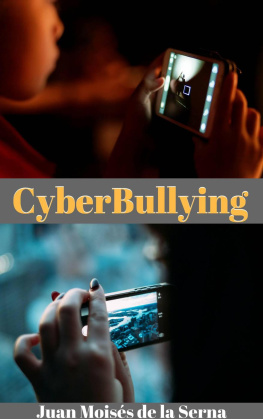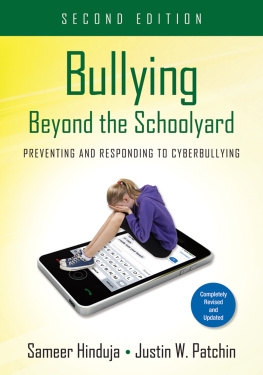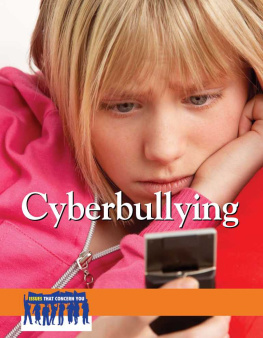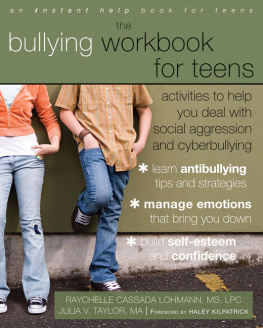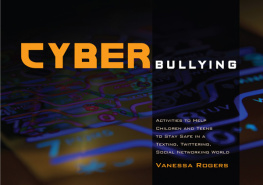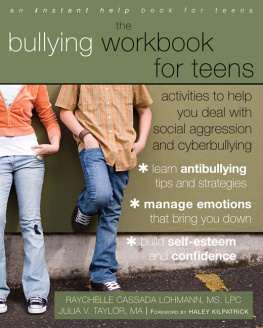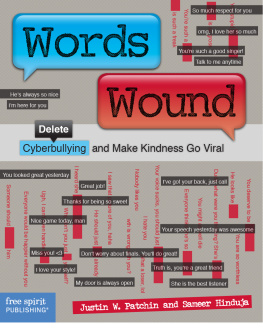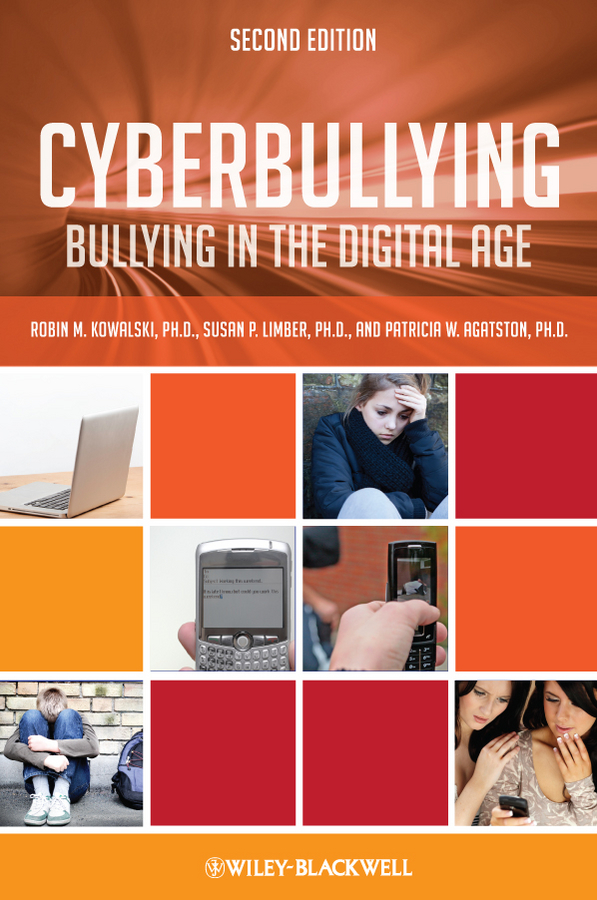PRAISE FOR PREVIOUS EDITION
It provides an excellent overview of bullying research in general, paying proper attention to research from around the world, and a good overview of the cyberbullying research, much of which the authors have been directly involved in conducting.
Research Papers in Education
Cyber Bullying provides the most current and essential information on the nature and prevalence of this epidemic, providing educators, parents, psychologists and policy-makers with critical prevention techniques and strategies for effectively addressing electronic bullying.
The Parent Report
Champions and critics of the [cyberbullying] laws agree that preventive education is a more powerful deterrent to cyberbullying than discipline. That notion is supported by Patricia Agatston, co-author of Cyber Bullying: Bullying in the Digital Age and a counselor at Cobb County School Districts Prevention-Intervention Center in Georgia.
Washington Post
A must-read for anyone who has access to technology, and it is particularly relevant for any parent and educator who works with youth. Cyber Bullying provides eye-opening and helpful suggestions for helping parents and educators monitor and track students use of technology. Provides a very useful roadmap for educators and parents about this phenomenon.
PsycCritiques
A very helpful guide to the cyber world for parents, teachers, school counselors and parent educators.
NASAP Family Newsletter
Much needed addition Mandatory reading for parents of adolescents and school personnel, administrators and teachers Now is the time to read this book.
Metapsychology
A useful introduction to the growing problem of electronic harassment among children. The chapters providing advice to parents and educators are quite helpful.
American Journal of Psychology
This book provides an eloquent mix of research theories and findings, together with actual experiences, in the important area of cyberbullying. It is especially strong in well-developed and comprehensive chapters about what parents and educators can do, to reduce both the likelihood of cyberbullying happening, and its negative consequences.
Peter K. Smith, Goldsmiths, University of London
ABOUT THE AUTHORS
Robin M. Kowalski, Ph.D., is Professor of Psychology at Clemson University. She is the author or coauthor of several books including Complaining, Teasing, and Other Annoying Behaviors (2003), Social Anxiety (1997), Aversive Interpersonal Behaviors (1997), Behaving Badly (2001), and The Social Psychology of Emotional and Behavioral Problems (2000).
Susan P. Limber, Ph.D., is the Dan Olweus Professor at the Institute on Family and Neighborhood Life and Professor of Psychology at Clemson University. She has published numerous articles on the topic of bullying. In 2004 she received the American Psychological Associations Early Career Award for Psychology in the Public Interest.
Patricia W. Agatston, Ph.D., is a Licensed Professional Counselor and Prevention Specialist with the Cobb County School Districts Prevention/Intervention Center in Marietta, Georgia. She was a participant in the CDCs Expert Panel on Electronic Media and Youth Violence, and has presented nationally and internationally on cyberbullying.

This second edition first published 2012
2012 Robin M. Kowalski, Susan P. Limber, Patricia W. Agatston
Edition History: Blackwell Publishing Ltd (1e, 2008)
Blackwell Publishing was acquired by John Wiley & Sons in February 2007. Blackwells publishing program has been merged with Wileys global Scientific, Technical, and Medical business to form Wiley-Blackwell.
Registered Office
John Wiley & Sons Ltd, The Atrium, Southern Gate, Chichester, West Sussex,
PO19 8SQ, UK
Editorial Offices
350 Main Street, Malden, MA 02148-5020, USA
9600 Garsington Road, Oxford, OX4 2DQ, UK
The Atrium, Southern Gate, Chichester, West Sussex, PO19 8SQ, UK
For details of our global editorial offices, for customer services, and for information about how to apply for permission to reuse the copyright material in this book please see our website at www.wiley.com/wiley-blackwell.
The right of Robin M. Kowalski, Susan P. Limber, and Patricia W. Agatston to be identified as the authors of this has been asserted in accordance with the UK Copyright, Designs and Patents Act 1988.
All rights reserved. No part of this publication may be reproduced, stored in a retrieval system, or transmitted, in any form or by any means, electronic, mechanical, photocopying, recording or otherwise, except as permitted by the UK Copyright, Designs and Patents Act 1988, without the prior permission of the publisher.
Wiley also publishes its books in a variety of electronic formats. Some content that appears in print may not be available in electronic books.
Designations used by companies to distinguish their products are often claimed as trademarks. All brand names and product names used in this book are trade names, service marks, trademarks or registered trademarks of their respective owners. The publisher is not associated with any product or vendor mentioned in this book. This publication is designed to provide accurate and authoritative information in regard to the subject matter covered. It is sold on the understanding that the publisher is not engaged in rendering professional services. If professional advice or other expert assistance is required, the services of a competent professional should be sought.
Library of Congress Cataloging-in-Publication Data
Kowalski, Robin M.
Cyberbullying : bullying in the digital age / Robin M. Kowalski, Susan P. Limber,
Patricia W. Agatston. 2nd ed.
p. cm.
Includes bibliographical references and index.
ISBN 978-1-4443-3480-7 (hardback) ISBN 978-1-4443-3481-4 (paperback)
1. Cyberbullying. 2. Bullying. I. Limber, Sue. II. Agatston, Patricia W. III. Title.
HV6773.K69 2012
302.343dc23
2011046026
A catalogue record for this book is available from the British Library.
FOREWORD
October 7, 2003, will always be the day that divides my life. Before that day, my son Ryan was alive. A sweet, gentle, and lanky 13-year-old fumbling his way through early adolescence and trying to establish his place in the often confusing and difficult social world of middle school. After that day, my son would be gone forever. A death by suicide. Some would call it bullycide or even cyberbullycide. I just call it a huge hole in my heart that will never heal.
Ryans young teen life included swimming, camping, skateboarding, biking, snowboarding, playing computer games and instant messaging. A typical array of healthy and normal teen activities or so it seemed. My son loved being online, staying connected with his friends after the school day and throughout the summer. But, during the summer of 2003, significantly more time was spent online, mainly instant messaging. I was concerned and felt compelled to remind him of our internet safety rules.
No IMing/chatting with strangers
No giving any personal information (name/address/phone) to strangers
No sending pictures to strangers
No secret passwords
Our last rule was a safety one. I told my two older children that they had to use the password I gave them for any accounts they signed up. I promised I would not read personal messages or spy on them but, God forbid you dont follow the first few rules and you just disappear one day. I will want instant access to all of your activities online. Never in a million years did I imagine this rule would someday end up becoming the key to unlocking the mystery of why my son took his own life.


